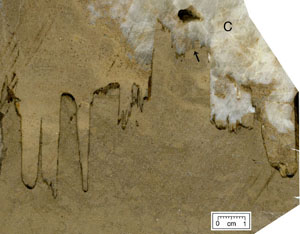| |||||||
|
|
|||||||
|
|
|||||||
| Teeth of Stylolites | |||||||
|
Columns and teeth (Figure 1) are characteristics of stylolites. The caps of the columns commonly contain thick seams of residue, while the sides of the columns were slickensided, indicating pressure solution across the caps and slip parallel to the column axis (Stockdale, 1922). Stockdale (1922) also suggested that the height or amplitude of the tooth is proportional to the amount of material dissolved, although Guzetta (1984) disputed this assertion. Safaricz and Davison (2005) showed that as pressure solution develops, the merging of two stylolites tends to reduce, if not completely remove, the amplitude of the stylolite tooth. Please see the section 'Amplitude of Stylolites' for more discussion. | |||||||
| Reference: |
|||||||
| Guzetta, G., 1984 Safaricz, M., Davison, I., 2005 Shaub, B.M., 1949 Stockdale, P.B., 1922 |
|||||||
|
Readme | About Us | Acknowledgement | How to Cite | Terms of Use | Ⓒ Rock Fracture Knowledgebase |
|||||||
